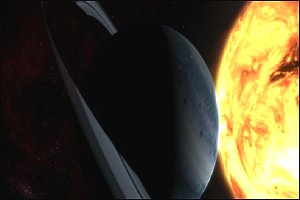The discovery extends the range of planet discovery far beyond the 180 light-year radius where over a hundred planets have been discovered so far. The new world orbits its parent star every 29 hours

Astronomers have discovered the most distant known planet to date - a large Jupiter-like planet 5,000 light-years from Earth. The discovery extends the range of planet discovery far beyond the 180 light-year radius where over a hundred planets have been discovered so far.
The new world orbits its parent star every 29 hours, closer than Mercury's orbit around the Sun. It could be distinguished because it passes in its orbit in front of the mother star as seen from Earth.
The planet was discovered during one of a number of surveys of stars in which they look for stars whose light dims as a result of the transit of a planet accompanying it.
The planet, known as Ogle-TR-56b is the second planet in total to be discovered using this method. The previous planet, HD 209458b was discovered in 1999. Detailed observations of its image in front of its parent star have allowed astronomers to discern for the first time many details about its atmosphere.
Astronomers from the Harvard-Smithsonian Center for Astrophysics announced the discovery of Ogle-TR-56b at the Astronomical Society meeting in Seattle.
A transit of a planet between us and its parent planet is a rare phenomenon. However, when such a transit occurs, it allows one to know more details about the planet than can be discovered in planets located by other means.
Ogle - stands for Optical Gravitational Lensing Experiment - a gravitational lensing and optical lensing experiment uses a telescope in Chile to monitor dense star fields towards the center of our galaxy.
Subsequent observations of the stars that are suspected of having planets around them show that the stars have dimmed - a sign that a planet has passed between them.
Dimitar Saslov, one of the discoverers of the New World says that astronomers are at the beginning of a new era of discoveries and have developed new ways to locate new worlds. Astronomers say that the diameter of the planet is 2.6 times that of Jupiter, but it weighs less than Jupiter to its diameter, and therefore its density is more similar to that of Saturn. It may have formed further away from the star it orbits but is moving into a closer orbit.
So far, over a hundred planets have been discovered, and on the way to approval two more candidates to be considered planets that were also discovered by Ogle.
